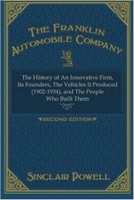Franklin Power - The First 100 Years
A unique tradition of quality, elegant simplicity, and technical leadership.
History compiled by R Canfield and RD Ricks, 17 May 1993
1893 H.H. Franklin Manufacturing Co. formed in Syracuse, New York, USA, by Herbert H. Franklin and Herbert G. Underwood (inventor) to produce die-castings. Mr. Franklin coins the term die casting.
1898 John Wilkinson builds prototype 4-cylinder engine - a design first, and the beginning in a long line of fine air cooled engines.
1901 Franklin and Wilkinson collaborate to develop Wilkinson's automobile.
1902 The first production Franklin is sold (now in the Smithsonian.) It has a 4 cylinder overhead valve engine mounted crosswise in the front, (You thought this was a new idea?), along with the first float carburetor and the first throttle control. It depends on forward motion to provide air flow for cooling, just as airplanes do today.
1902 Wilkinson's principles of "Scientific Light Weight," simplicity, flexible construction, quality, and advanced fundamental concepts such as light unsprung weight and direct air cooling lead to many future wins in reliability and speed contests. Extensive use of wood and aluminum keeps the cars light and strong.
1904 A little Franklin roadster sets a record of 33 days coast to coast, beating the old record of 61 days, proving Franklin superiority.
1905 First six-cylinder car in America. It is turned inline, requiring a cooling fan. It has overhead valves, of course.
1906 Six-cylinder Franklin halves the old coast to coast record, making the trip in 15 days.
1907 Automatic spark advance introduced - another Franklin first.
1907 H.H. Franklin Co. is world's largest user of aluminum, while producing cars, die-castings and trucks.
1908 Hemispherical combustion chambers - another "modern idea."
1911 Hood is raked and streamlined, taking advantage of direct air cooling.
1912 Recirculating pressure feed oil system - a Franklin first.
1913 A 1911 Franklin Speed Car sets a world's economy record of 83.5 mpg.
1913 Franklin is a pioneer with closed body sedan
1913 Intake heated via exhaust - Franklin first.
1914 32.8 mpg average in nationwide test of 94 standard production Franklins.
1917 40.3 mpg average in nationwide test of 179 cars. War production includes a 1-cyl. powerplant, and aircraft engine parts for Hispano-Suiza and Rolls Royce.
1921 The hood is made to look more like a radiator on other cars to stimulate sales.
1925 In another effort to increase sales, a major body redesign brings a very conventional, now classic, radiator look.
1929 Horsepower and efficiency gains enable a Franklin at the hands of Cannon Ball Baker to set a new coast to coast record of 69 hours.
1930 New engine design produces the highest horsepower per cubic inch in America, after Deusenberg. New engine also flown in Waco biplane.
1932 The big V-12 (150hp, 398cid) is introduced - again direct air cooled.
1932 Franklin Olympic introduced, mating the 100hp six to a Reo Flying Cloud. At 3500 pounds, it's the muscle car of its day.
1933 Carl Doman and Ed Marks, ex-Franklin engineers, start Doman- Marks Engine Co. They produce another leap forward - the "Domark" heavy duty air-cooled industrial engines.
1934 Car production ends as H.H. Franklin Co. is bankrupted in the Great Depression.
1937 Doman-Marks Engine Co. buys rights to Franklin. Domark engines now called Franklin, and name changed to Aircooled Motors Corp.
1938 Franklin flies again. 4-cylinder opposed air cooled automotive and aircraft engines developed. Most parts are common to both types of engines. These are among the first successful opposed engines - standard on all future light aircraft. They pioneer the use of some equipment which the industry finally adopts decades later.
1940 First modern opposed 6-cylinder engine is part of the second generation of Franklin aircraft engines. Today they would be called modular engines.
1940 4-cylinder engine powers Sikorsky VS-300A, the first practical helicopter, and a pair of sixes propel the first Nothrop Flying Wing, the N-1M.
1942 Franklin engines power many light airplanes and drones for the war effort.
1945 Two 8-cylinder supercharged, opposed Franklins propel Northrop N-9MB Flying Wing into history. This is the predecessor of the YB-49 and the B-2 Stealth Bomber. It is flying again, out of Chino, Calif.
1946 Thousands of engines are built in this and following years to power helicopters and light airplanes, including the first certified civil helicopter. Franklins power 3 out of 4 helicopters built over the next decade.
1947 Franklin engine is used as Auxiliary Power Unit in the Northrop YB-49 jet powered flying wing.
1948 178hp helicopter engine is fitted with water(!) jackets to drive the amazing Tucker car into history. Tucker buys Franklin (Aircooled Motors, Inc.)
1951 The H.H. Franklin Club is formed to foster all pre-war air cooled cars and "the Franklin Spirit."
1960 All 1925 series 11 and later Franklins but the Olympics are designated Classics by the prestigious Classic Car Club of America.
1961 Tucker debt paid and Franklin sold at auction to Aero Industries, never to really recover from the drain of capital.
1974 220hp Franklin is widely rated the best light airplane engine ever built.
1975 Bankruptcy again. Rights and drawings are bought by the Polish government, which begins manufacture of PZL-F engines for twin Pipers and other airplanes built in Poland.
1990 A 1946 Bellanca and a 1947 Stinson fly from London to Australia in the grueling World Vintage Air Rally for airplanes built prior to 1950. Only these two of the 25 in the rally have Franklin engines, and are two of only 8 to finish.
1992 Aircraft engines and parts once again become available - from Poland.
1992 First official gathering of Franklin car and aircraft engine enthusiasts during 23rd annual HHFC Westrek at Hemet, Calif., airport.
1993 July 4th - 100th anniversary of the H.H. Franklin Manufacturing Co.

